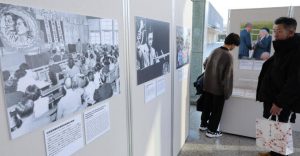Nihon Hidankyo awarded Nobel Peace Prize: Peace Museum exhibition commemorating award reveals history of nuclear-abolition movement through photos
Dec. 26, 2024
by Michio Shimotaka, Staff Writer
On December 25, an exhibition commemorating the Japan Confederation of A- and H-Bomb Sufferers Organizations (Nihon Hidankyo) being awarded the Nobel Peace Prize began at the Hiroshima Peace Memorial Museum, located in Hiroshima’s Naka Ward. Images of Nihon Hidankyo’s history and the award ceremony are introduced with panels of photographs. Personal accounts of atomic bomb survivors’ experiences in the atomic bombing, compiled by Hidankyo’s prefectural organizations, are also on display. The exhibition is to continue until the end of August 2025. Admission is free.
Eight photo panels are displayed in the first-floor lobby on the north side of the museum’s East Building. A photo capturing the inaugural meeting of the Hiroshima Prefectural Confederation of A-bomb Sufferers Organizations (Hiroshima Hidankyo), held on May 27, 1956, includes a hanging banner that reads, “National compensation for sufferers of atomic and hydrogen bombs,” conveying the movement’s starting point. There is also a photo of Terumi Tanaka, 92, co-chair of Nihon Hidankyo, who spoke at the award ceremony on December 10.
The exhibition includes four replicas of large square cards covered with a collection of messages that Hiroshima Hidankyo, chaired by Toshiyuki Mimaki, received from A-bomb survivors in 2002. The group’s former chair, Sunao Tsuboi, who died in 2021, inscribed a message on one of the cards that reads, “Peace is secured through the power of reason.” In the library on the museum’s basement floor are displayed 22 materials, including a newsletter issued by Nihon Hidankyo, as well as 69 A-bomb survivors’ accounts of their experiences in the atomic bombing. Some of the materials can be borrowed from the museum.
The exhibition is organized by the Hiroshima City government and the Hiroshima Peace Culture Foundation. Hironobu Ochiba, chief curator at the museum, said, “We hope visitors can understand the history of how the A-bomb survivors’ steady calls for nuclear abolition came to be gradually recognized by the international community, and consider what they can do to advance the movement to eliminate nuclear weapons.”
(Originally published on December 26, 2024)
On December 25, an exhibition commemorating the Japan Confederation of A- and H-Bomb Sufferers Organizations (Nihon Hidankyo) being awarded the Nobel Peace Prize began at the Hiroshima Peace Memorial Museum, located in Hiroshima’s Naka Ward. Images of Nihon Hidankyo’s history and the award ceremony are introduced with panels of photographs. Personal accounts of atomic bomb survivors’ experiences in the atomic bombing, compiled by Hidankyo’s prefectural organizations, are also on display. The exhibition is to continue until the end of August 2025. Admission is free.
Eight photo panels are displayed in the first-floor lobby on the north side of the museum’s East Building. A photo capturing the inaugural meeting of the Hiroshima Prefectural Confederation of A-bomb Sufferers Organizations (Hiroshima Hidankyo), held on May 27, 1956, includes a hanging banner that reads, “National compensation for sufferers of atomic and hydrogen bombs,” conveying the movement’s starting point. There is also a photo of Terumi Tanaka, 92, co-chair of Nihon Hidankyo, who spoke at the award ceremony on December 10.
The exhibition includes four replicas of large square cards covered with a collection of messages that Hiroshima Hidankyo, chaired by Toshiyuki Mimaki, received from A-bomb survivors in 2002. The group’s former chair, Sunao Tsuboi, who died in 2021, inscribed a message on one of the cards that reads, “Peace is secured through the power of reason.” In the library on the museum’s basement floor are displayed 22 materials, including a newsletter issued by Nihon Hidankyo, as well as 69 A-bomb survivors’ accounts of their experiences in the atomic bombing. Some of the materials can be borrowed from the museum.
The exhibition is organized by the Hiroshima City government and the Hiroshima Peace Culture Foundation. Hironobu Ochiba, chief curator at the museum, said, “We hope visitors can understand the history of how the A-bomb survivors’ steady calls for nuclear abolition came to be gradually recognized by the international community, and consider what they can do to advance the movement to eliminate nuclear weapons.”
(Originally published on December 26, 2024)








